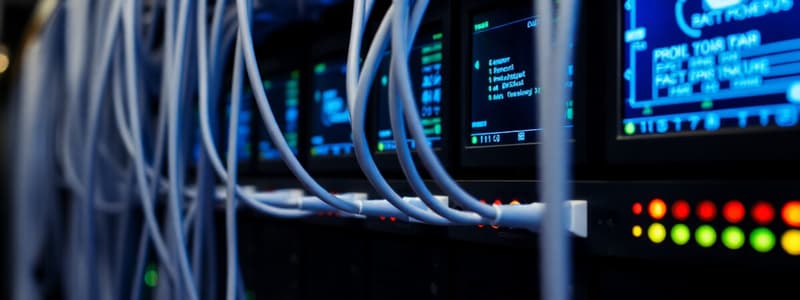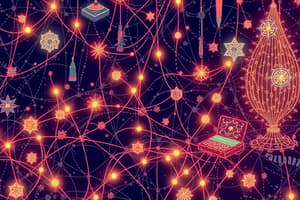Podcast
Questions and Answers
What is a protocol?
What is a protocol?
- A set of rules that govern communication between devices on a network. (correct)
- A way of measuring the speed of data transfer on a network.
- A type of software that allows users to access the internet.
- A physical connection between two devices on a network.
Which of these is NOT an example of a human protocol?
Which of these is NOT an example of a human protocol?
- Saying "hello" as a greeting.
- Sending a TCP connection request. (correct)
- Using a specific format for a business letter.
- Shaking hands as a sign of respect.
What is the role of "edge systems" in network structure?
What is the role of "edge systems" in network structure?
- They are responsible for routing data packets within the network core.
- They connect different networks together, forming a larger network.
- They ensure the security of data transmission across the network.
- They provide access to the network for users and devices. (correct)
Which of these is NOT a type of access network?
Which of these is NOT a type of access network?
What is the meaning of "bandwidth" in relation to an access network?
What is the meaning of "bandwidth" in relation to an access network?
Which of these describes a "shared" access network?
Which of these describes a "shared" access network?
Flashcards
Copyright
Copyright
Legal protection for original works and content.
Adapted slides
Adapted slides
Slides modified from original works for personal use.
PowerPoint slides
PowerPoint slides
Visual presentation format for sharing information.
Open access material
Open access material
Signup and view all the flashcards
Source attribution
Source attribution
Signup and view all the flashcards
Network Edge
Network Edge
Signup and view all the flashcards
End Systems
End Systems
Signup and view all the flashcards
Packet Switches
Packet Switches
Signup and view all the flashcards
Protocols
Protocols
Signup and view all the flashcards
Internet Service Providers (ISPs)
Internet Service Providers (ISPs)
Signup and view all the flashcards
DSL
DSL
Signup and view all the flashcards
Cable Modem
Cable Modem
Signup and view all the flashcards
HFC
HFC
Signup and view all the flashcards
Ethernet
Ethernet
Signup and view all the flashcards
Wireless LAN
Wireless LAN
Signup and view all the flashcards
Physical Media
Physical Media
Signup and view all the flashcards
Packet Transmission Delay
Packet Transmission Delay
Signup and view all the flashcards
Human Protocols
Human Protocols
Signup and view all the flashcards
Network Protocols
Network Protocols
Signup and view all the flashcards
Protocol Definition
Protocol Definition
Signup and view all the flashcards
Access Networks
Access Networks
Signup and view all the flashcards
Network Core
Network Core
Signup and view all the flashcards
Bandwidth
Bandwidth
Signup and view all the flashcards
Shared vs. Dedicated Network
Shared vs. Dedicated Network
Signup and view all the flashcards
Study Notes
Introduction to Computer Networking
- The provided slides are freely available for use by faculty, students, and readers.
- Slides can be adapted, modified, and used as needed.
- If using the slides, the source should be cited.
- When posting slides online, acknowledge the adaptation and copyright.
Chapter 1 Roadmap
- 1.1 What is the Internet?: Fundamental questions about the Internet.
- 1.2 Network Edge: End systems, access networks, links.
- 1.3 Network Core: Packet switching, circuit switching, network structures.
- 1.4 Delay, Loss, Throughput in Networks: Analyzing network performance metrics.
- 1.5 Protocol Layers, Service Models: Understanding different layers and their functions in network communication.
- 1.6 Networks Under Attack: Security: Examining security issues in networking.
- 1.7 History: Overview of the evolution of networking.
Network Structure
- Network Edge: Hosts (clients and servers), data centers.
- Access Networks: Physical media (wired, wireless), communication links.
- Network Core: Interconnected routers, network of networks.
Access Networks and Physical Media
- Residential Access: Residential networks.
- Institutional Access: School and company networks.
- Mobile Access: Mobile networks.
- Bandwidth: The bits per second access network can handle.
- Shared/Dedicated Networks: Understanding how resources are allocated.
Access Network Examples
- DSL (Digital Subscriber Line): Uses existing telephone lines, with dedicated lines for voice and data transmission. Upstream and downstream rates vary (e.g., 1-2.5 Mbps up, <24 Mbps down).
- Cable Network: Uses shared cable lines, and frequency division multiplexing, with different channels for data and TV transmission. HFC offers asymmetric bandwidth rates (e.g., up to 30Mbps down, 2Mbps up).
- Home Network: Combining multiple wireless and wired devices into a single network using a router, firewall, NAT, and wired/wireless access.
- Enterprise Access: Ethernet networks used by companies and universities. Fast data transfer rates typical.
- Wireless Access: Shared networks connected via base stations (access points). LANs (local area networks) support 802.11b/g (WiFi). Wide-area networks like 3G and LTE.
Protocols
- Human Protocols: Everyday interactions (e.g., "What's the time?").
- Network Protocols: Precise, automated communication rules for machines (e.g., TCP, IP, HTTP).
- Protocol Format and Order: Defining messages, their format, and sequence for communications between network entities.
- Actions on Message Transmission and Receipt: Outline actions taken when a message is sent and received.
Protocols: Example
- TCP connection request and response: Part of the communication protocol for getting a file from a website.
What's a Protocol? (Illustration)
- Shows human protocol ("Hi", "Got the time?") and computer network counterpart (e.g., TCP connection messages).
Host: Sending Packets of Data
- Hosts break messages into packets.
- Packets are transported across the network.
- Sending speed (transmission rate) is a parameter.
Physical Media
- Bit Propagation: Transmission of bits between transmitter and receiver via physical connections.
- Guided Media: Transmission through wires (e.g., twisted pair, coaxial, fiber).
- Unguided Media: Broadcasting, such as radio waves.
Physical Media Types
- Twisted Pair (TP): Two insulated copper wires (e.g., Ethernet).
- Coaxial Cable: Two concentric copper conductors.
- Fiber Optic: Glass fiber carrying light pulses.
Physical Media: Radio
- Signals are propagated using electromagnetic spectrum.
- Radio Link Types: Terrestrial microwave, LANs, cellular (3G, 4G, LTE), satellite networks.
- Propagation Effects: Interference, reflection, obstruction.
Delay and Loss
- Packet Queuing: Packets wait in buffers if the arrival rate is higher than the network capacity. Loss occurs when buffers overflow.
- Delay Sources: Transmission delay, propagation delay, nodal processing delay, and queuing delay.
- Caravan Analogy: Illustrates the concepts of transmission time and propagation time using car/truck analogies.
Throughput
- Throughput: The rate of bits sent and received over time.
- Instantaneous Throughput: Throughput at a particular moment.
- Average Throughput: Throughput measured over an extended period.
- Bottleneck Link: Limits total throughput in a network path.
Traceroute
- Tool to measure delays and loss from the source to the destination router by sending probes.
- Network delays and routes can be tracked using the traceroute command.
Packet Loss
- Buffer Overflow: When the buffer capacity is exceeded, packets are dropped.
- Retransmission: Strategies for handling lost packets.
Studying That Suits You
Use AI to generate personalized quizzes and flashcards to suit your learning preferences.



